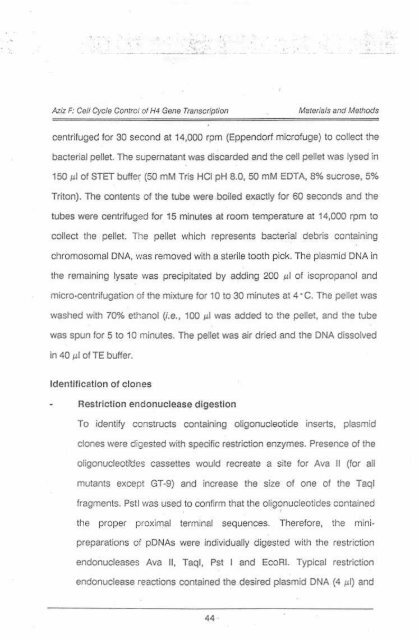Page 1 \ ?^p 6r.1 CELL CYCLE CONTROL OF HUMAN H4 ...
Page 1 \ ?^p 6r.1 CELL CYCLE CONTROL OF HUMAN H4 ...
Page 1 \ ?^p 6r.1 CELL CYCLE CONTROL OF HUMAN H4 ...
Create successful ePaper yourself
Turn your PDF publications into a flip-book with our unique Google optimized e-Paper software.
AzE F: Cel Cvcle Cotuat at <strong>H4</strong> eqe ftanscttoltan<br />
c€nrriluged lor 30 second at 14,000 lpm (Eppendori microiLrge) to colect the<br />
bacterial pellet. The supernalant was discsrdod and the ce|l p€llet was lysed in<br />
150 /r or STEI bufer (50 mM Tis HCr pH 8-0, 50 mM EDTA, a% sucrose, 5%<br />
Tdton). The conrenb ol the rub€ w6r6 boited exactly tor @ seco.ds a.d the<br />
rub€s wer€ canrrituged for 15 minutss al room temperarure st 14,000 rpm io<br />
collect tlra pellet. The pellgt which r6pr€sents bacterial debris co.taining<br />
chrornosomal DNA, was removed with ast€r16tooth pick. Ths plasmd ONA ln<br />
lho romaining lysate was prscipitatsd by addlng 200 /rl ol isopfopano and<br />
micro-cenl.ilugaton ol the mixtule tof 10 to 30 minutes at 4'C. The pe l€l was<br />
washed with 70% elhanol (1e, 10O &l was added to the pellet, and the lube<br />
was spun 5 ro 10 minutes, Ihe pellst was at dried and the oNA dissolved<br />
'or<br />
in 40 rlolTE buffer.<br />
ldentltlcatlon ot clones<br />
Restriction endonuclsase dl9ssllon<br />
To identify co.structs containing oligonucleotide inserls, plasmid<br />
clones we.e digested wirh specilic restrictjon enzymes. Presenc€ ol lhe<br />
oliqonucleoides cassetles would recreate a site lor Ava ll (lor all<br />
mlranrs sxcepr GT.g) and increasa the size ot one ol rhe Taql<br />
l.agments. Pst was used to conlirm thatrhe oligonucleotides contai.ed<br />
lhe proper proxmal l€rmlnal soquences. Thereiore, lhe mini<br />
preparations of pDNAs wefo individually digesied wilh lhe restricron<br />
endonucleases Ava ll, Taql, Psl I and E@Rl. Typical .esviclion<br />
endonuclease reaclions morained lhe desired plasmid DNA (4 /l) and

















